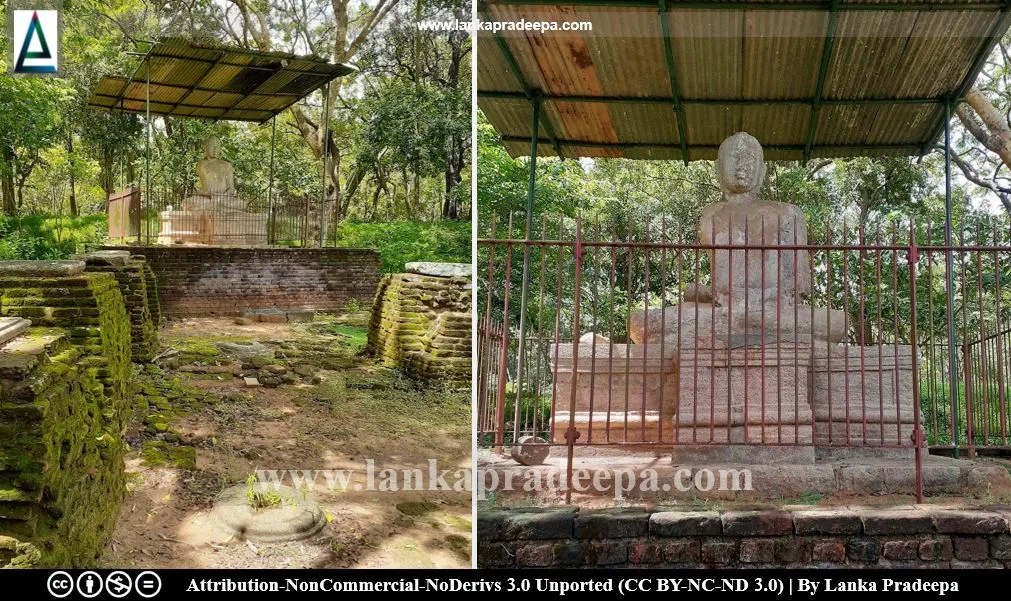
|
Third Samadhi Statue and Bodhigharaya III |
Bodhi Tree Shrine III, Abhayagiriya, incorrectly referred to as the Shrine of the Diamond Throne (Sinhala: අභයගිරිය තෙවන සමාධි බුදු පිළිමය හා බෝධිඝරය) is a Bodhigharaya (a Bodhi tree shrine) located on the premises of Abhayagiri Monastery in Anuradhapura District, Sri Lanka. It lies to the south of the Ratnaprasadaya, the Chapter House of Abhayagiri Viharaya.
History
This is considered the oldest Bodhi tree shrine of Abhayagiri Monastery and is believed to be the one that is reported in the memoir records of Fa-Hsien, the famous Chinese monk who stayed in Sri Lanka from 411 to 413 A.D. According to his report, a former king had planted the Bodhi tree at this place from a seed brought from the Sri Maha Bodhi Tree in India (Jayasuriya, 2016). The report further reveals that there was a building surrounding the Bodhi tree (Jayasuriya, 2016).
Ruins belonging to four construction phases, from the 1st century B.C. to the 10th century A.D., are found at this site (Jayasuriya, 2016). The Asana and Siri Pathul Gal (footprints of the Buddha) indicate that this site belonged to a very early period (Jayasuriya, 2016).
The Site
The site is 28.25 m long and 25 m wide (Hettiaratchi & Kulatunge, 1993). The ruins in this place include an Asanaghara (a shrine encircling a seat/throne), Siri Pathul Gal, a broken Buddha statue, a pit for a Bodhi tree, and two slab inscriptions of King Kassapa V (914-923 A.D.) and King Mahinda IV [(956-972 A.D.) Ranawella, 2001; Ranawella, 2004; Uduwara, 1990]. The ruins of the Asanaghara were unearthed by S. M. Burrows, Assistant Government Agent, four years before the establishment of the Archaeology Department (Uduwara, 1990). The Asana (seat) is 5.5 by 1.83 m in dimension (Hettiaratchi & Kulatunge, 1993). The seated Buddha statue in Samadhi posture is 1.75 m in height and the pedestal is 0.75 m in height (Hettiaratchi & Kulatunge, 1993). The middle portion of the front of the seat protrudes while the rear of the seat is straight and measures 2.5 m in length (Hettiaratchi & Kulatunge, 1993). The width of the seat is 1.5 m (Hettiaratchi & Kulatunge, 1993).
The main entrance to the site was located on the east and it is presently known as the Burrows Pavilion (Wikramagamage, 2004). Some inscriptions and Buddha statues discovered from this site are presently preserved in the Archaeological Museum at Anuradhapura (Wikramagamage, 2004).
Burrows Pavilion (or Stone Canopy)

The entrance porch to the Bodhi tree shrine is presently known as the Burrows Pavilion because it was restored by S.M. Burrows (Hettiaratchi & Kulatunge, 1993).
Buddha Statues
Besides the present statue at the site, two more Buddha statues were discovered during the excavations done in 1962 (Wikramagamage, 2004). Of them, one statue received the attention of scholars as it has some primitive features of the ancient Buddha statues sculptured in Andra in India (Wikramagamage, 2004). According to the view of Wikramagamage, this statue is probably a creation of the 3rd-2nd century B.C. (Wikramagamage, 2012).
The two statues were later taken to the Anuradhapura Archaeological Museum for preservation, but one is said to have decayed on the museum premises (Wikramagamage, 2004). The broken Buddha statue that has been placed at the present site is a creation of a Sri Lankan artist of the Abhayagiri School (Wikramagamage, 2004).
Inscriptions
Two large slab inscriptions belonging to King Kassapa V (914-923 A.D.) and King Mahinda IV (956-972 A.D.) are found at the site (Uduwara, 1990). Of them, The Inscription of Kassapa V contains a set of regulations promulgated by the king concerning the administration of several monastic establishments attached to Abhayagiriya and Mihintale monasteries (Ranawella, 2001). The inscription of Mahinda IV contains an account of the religious monuments which the king had built and restored and a general survey of the charitable works he had performed (Ranawella, 2004).

|
The Asana (seat) and Siri Pathul Gal |
Related Posts
Read Also
References
Books
1) Hettiaratchi, S. B., Kulatunge, T. G., 1993. Abhayagiriya. Unesco/World Food Programme, Sri Lanka Cultural Triangle, Abhayagiri Vihara Project. Central Cultural Fund. pp.19-20.
2) Jayasuriya, E., 2016. A guide to the Cultural Triangle of Sri Lanka. Central Cultural Fund. ISBN: 978-955-613-312-7. pp.27-28.
3) Ranawella, S., 2001. Inscription of Ceylon. Volume V, Part I. Department
of Archaeology. ISBN: 955-9159-21-6. pp.329-336.
4) Ranawella, G.S., 2004. Inscription of Ceylon. Volume V, Part
II. Department of Archaeology. ISBN: 955-9159-30-5. pp.245-252.
5) Uduwara, J., 1990. History of the Department of Archaeology, 1970-1990. Archaeological Department Centenary (1890-1990): Commemorative series: Volume I: History of the Department of Archaeology. p.166.
6) Wikramagamage, C., 2004. Heritage of Rajarata: Major natural, cultural, and historic sites. Colombo. Central Bank of Sri Lanka. pp.102-103.
7) Wikramagamage, C., 2012. Rajarata Sanskrutika Urumaya (In Sinhala). Author publication. ISBN: 978-955-53322-2-4. pp.92-93,119-121.

